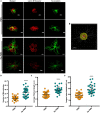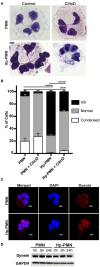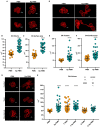Microtubules and Dynein Regulate Human Neutrophil Nuclear Volume and Hypersegmentation During H. pylori Infection
- PMID: 33828562
- PMCID: PMC8019731
- DOI: 10.3389/fimmu.2021.653100
Microtubules and Dynein Regulate Human Neutrophil Nuclear Volume and Hypersegmentation During H. pylori Infection
Abstract
Neutrophils (also called polymorphonuclear leukocytes, PMNs) are heterogeneous and can exhibit considerable phenotypic and functional plasticity. In keeping with this, we discovered previously that Helicobacter pylori infection induces N1-like subtype differentiation of human PMNs that is notable for profound nuclear hypersegmentation. Herein, we utilized biochemical approaches and confocal and super-resolution microscopy to gain insight into the underlying molecular mechanisms. Sensitivity to inhibition by nocodazole and taxol indicated that microtubule dynamics were required to induce and sustain hypersegmentation, and super-resolution Stimulated Emission Depletion (STED) imaging demonstrated that microtubules were significantly more abundant and longer in hypersegmented cells. Dynein activity was also required, and enrichment of this motor protein at the nuclear periphery was enhanced following H. pylori infection. In contrast, centrosome splitting did not occur, and lamin B receptor abundance and ER morphology were unchanged. Finally, analysis of STED image stacks using Imaris software revealed that nuclear volume increased markedly prior to the onset of hypersegmentation and that nuclear size was differentially modulated by nocodazole and taxol in the presence and absence of infection. Taken together, our data define a new mechanism of hypersegmentation that is mediated by microtubules and dynein and as such advance understanding of processes that regulate nuclear morphology.
Keywords: dynein; hypersegmentation; lamin B receptor; microtubules; neutrophils; plasticity.
Copyright © 2021 Silva-Del Toro and Allen.
Conflict of interest statement
The authors declare that the research was conducted in the absence of any commercial or financial relationships that could be construed as a potential conflict of interest.
Figures







Similar articles
-
Helicobacter pylori-infected human neutrophils exhibit impaired chemotaxis and a uropod retraction defect.Front Immunol. 2022 Oct 20;13:1038349. doi: 10.3389/fimmu.2022.1038349. eCollection 2022. Front Immunol. 2022. PMID: 36341418 Free PMC article.
-
Cutting Edge: Helicobacter pylori Induces Nuclear Hypersegmentation and Subtype Differentiation of Human Neutrophils In Vitro.J Immunol. 2017 Mar 1;198(5):1793-1797. doi: 10.4049/jimmunol.1601292. Epub 2017 Feb 1. J Immunol. 2017. PMID: 28148734 Free PMC article.
-
Effect of inhibition of dynein function and microtubule-altering drugs on AAV2 transduction.Virology. 2007 Oct 10;367(1):10-8. doi: 10.1016/j.virol.2007.05.009. Epub 2007 Jun 22. Virology. 2007. PMID: 17588632 Free PMC article.
-
Microtubule-dependent changes in assembly of microtubule motor proteins and mitotic spindle checkpoint proteins at PtK1 kinetochores.Mol Biol Cell. 2001 Jul;12(7):1995-2009. doi: 10.1091/mbc.12.7.1995. Mol Biol Cell. 2001. PMID: 11451998 Free PMC article.
-
[Dynein and dynactin as organizers of the system of cell microtubules].Ontogenez. 2006 Sep-Oct;37(5):323-39. Ontogenez. 2006. PMID: 17066975 Review. Russian.
Cited by
-
Unresolved Issues in Familial Mediterranean Fever: Is p.R202Q MEFV Variant Potentially Pathogenetic in Unleashing Inflammation?J Clin Immunol. 2025 Jun 10;45(1):104. doi: 10.1007/s10875-025-01898-8. J Clin Immunol. 2025. PMID: 40493122 Free PMC article.
-
Helicobacter pylori-infected human neutrophils exhibit impaired chemotaxis and a uropod retraction defect.Front Immunol. 2022 Oct 20;13:1038349. doi: 10.3389/fimmu.2022.1038349. eCollection 2022. Front Immunol. 2022. PMID: 36341418 Free PMC article.
-
Effects of the pan-caspase inhibitor Q-VD-OPh on human neutrophil lifespan and function.PLoS One. 2025 Jan 7;20(1):e0316912. doi: 10.1371/journal.pone.0316912. eCollection 2025. PLoS One. 2025. PMID: 39775346 Free PMC article.
-
Helicobacter pylori infection delays neutrophil apoptosis and exacerbates inflammatory response.Future Microbiol. 2024 Sep;19(13):1145-1156. doi: 10.1080/17460913.2024.2360798. Epub 2024 Jul 26. Future Microbiol. 2024. PMID: 39056165 Free PMC article.
-
Advancements in Single-Molecule Fluorescence Detection Techniques and Their Expansive Applications in Drug Discovery and Neuroscience.Biosensors (Basel). 2025 Apr 30;15(5):283. doi: 10.3390/bios15050283. Biosensors (Basel). 2025. PMID: 40422023 Free PMC article. Review.
References
Publication types
MeSH terms
Substances
Grants and funding
LinkOut - more resources
Full Text Sources
Other Literature Sources
Medical

